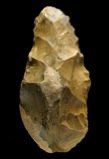lithics
Who made the Aurignacian?
30/05/09 23:40 Filed in: Palaeoanthropology
Until recently, it was largely assumed that the Aurignacian was contemporaneous with the arrival of anatomically modern humans in Europe sometime around 40,000 years ago. This industrial complex is named after the site of Aurignac in southern France and is found throughout Europe and southwest Asia. The evidence for an association between modern humans the Aurignacian has been less than clear cut.
For most of the last century, the prevalent view among archaeologists was that Neandertals only made Mousterian tools. However, the discovery of the St Césaire 1 Neandertal skeleton and the Neandertal remains from Arcy-sur-Cure with Châtelperronian industry put paid to this idea. Châtelperronian tools show a mix of features otherwise found in the Mousterian and Aurignacian industries. What was particularly surprising about the Châtelperronian culture was not only the lithics but also the manufacture of bone tools and personal ornaments. At the site of Arcy-sur-Cure archaeologists found pierced teeth, ivory, shell, and bone in the Châtelperronian layers. The Szeletian industry of central Europe and the Uluzzian industry of Italy may also be related to the Châtelperronian.
Read More...
For most of the last century, the prevalent view among archaeologists was that Neandertals only made Mousterian tools. However, the discovery of the St Césaire 1 Neandertal skeleton and the Neandertal remains from Arcy-sur-Cure with Châtelperronian industry put paid to this idea. Châtelperronian tools show a mix of features otherwise found in the Mousterian and Aurignacian industries. What was particularly surprising about the Châtelperronian culture was not only the lithics but also the manufacture of bone tools and personal ornaments. At the site of Arcy-sur-Cure archaeologists found pierced teeth, ivory, shell, and bone in the Châtelperronian layers. The Szeletian industry of central Europe and the Uluzzian industry of Italy may also be related to the Châtelperronian.
Read More...
0 Comments

